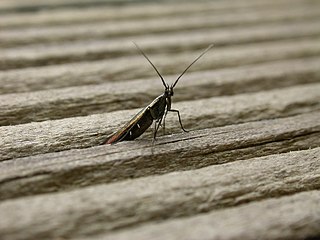
Kalmia is a genus of about ten species of evergreen shrubs from 0.2–5 m tall, in the family Ericaceae. They are native to North America and Cuba. They grow in acidic soils, with different species in wet acid bog habitats and dry, sandy soils.

Fred Gannon Rocky Bayou State Park is a Florida State Park located on the northwestern coast of the U.S. state of Florida, southeast of Niceville. The address is 4281 Highway 20. Native American middens and artifacts can be seen throughout the park.

The Coleophoridae are a family of small moths, belonging to the huge superfamily Gelechioidea. Collectively known as case-bearers, casebearing moths or case moths, this family is represented on all continents, but the majority are found in temperate areas of the Northern Hemisphere. They are most common in the Palearctic, and rare in sub-Saharan Africa, South America, and Australia; consequently, they probably originated in northern Eurasia. They are relatively common in houses, they seek out moist areas to rest and procreate.

Coleophora is a very large genus of moths of the family Coleophoridae. It contains some 1,350 described species. The genus is represented on all continents, but the majority are found in the Nearctic and Palaearctic regions. Many authors have tried splitting the genus into numerous smaller ones, but most of these have not become widely accepted.

Kunzea ericoides, commonly known as kānuka, kanuka, or white tea-tree, is a tree or shrub in the myrtle family, Myrtaceae and is endemic to New Zealand. It has white or pink flowers similar to those of Leptospermum and from its first formal description in 1832 until 1983 was known as Leptospermum ericoides. The flowers have five petals and up to 25 stamens which are mostly longer than the petals.

Santolina is a genus of plants in the chamomile tribe within the sunflower family, primarily from the western Mediterranean region.

Symphyotrichum ericoides, known as white heath aster, frost aster, or heath aster, is a species of flowering plant in the family Asteraceae native to much of central and eastern North America. It has been introduced to parts of Europe and western Asia.

Ericameria ericoides, known by the common names California goldenbush, mock heather, and California heathgoldenrod, is a species of flowering shrubs in the family Asteraceae. It is endemic to California, where it grows in the sand dunes and coastal hills between the northern San Francisco Bay Area and the Los Angeles area.

Chaetopappa ericoides is a species of flowering plant in the family Asteraceae known by the common names rose heath and heath-leaved chaetopappa. It is native to the southwestern and western Great Plains regions of the United States, plus northern Mexico. It is found in California, Nevada, Arizona, Utah, New Mexico, Colorado, Wyoming, Texas, Oklahoma, Kansas, Nebraska, Chihuahua, Coahuila, Sonora, Durango, Zacatecas, San Luis Potosí, and Nuevo León.

Coleophora serratella is a moth of the family Coleophoridae. It is found in Europe, Japan (Hokkaido) and North America.

Coleophora limosipennella is a moth of the family Coleophoridae described by Philogène Auguste Joseph Duponchel in 1843. It is found in Europe from Fennoscandia to the Pyrenees, Italy and the Balkan Peninsula and from Great Britain to the Baltic States and Romania. It is an introduced species in North America.

Coleophora anatipennella is a moth of the case-bearer family (Coleophoridae).

The clover case-bearer or small clover case-bearer is a moth of the family Coleophoridae. It is native to Asia, Europe and North Africa, and has been introduced to Australia and New Zealand.

The metallic coleophora moth is a moth of the family Coleophoridae. It is native to Europe and Armenia, but is an adventive species in the Nearctic realm, where it is found throughout the United States and southern Canada. It has also been recorded from New Zealand, Chile and Argentina.

Coleophora auricella is a moth of the family Coleophoridae. It is found from Germany and Poland to Spain, Italy and Romania. It has also been recorded from southern Russia.

Coleophora colutella is a moth of the family Coleophoridae. It is found in all of Europe, except Great Britain and Ireland. It is an introduced species in North America.
Coleophora oriolella is a moth of the family Coleophoridae. It is found in Germany and Poland to the Iberian Peninsula, Sardinia, Sicily and Greece and from France to southern Russia.
Coleophora dianthi is a moth of the family Coleophoridae. It is found in most of Europe, Russia, Turkey and Iraq.

Hypericum ericoides is a dwarf shrub in the flowering plant family Hypericaceae, section Coridium. It is found in eastern and southeastern Spain, Morocco, and Tunisia. Its preferred habitat is fissures in calcareous rocks in warm, sunny places, from 200 to 2,000 meters above sea level (MASL).

Crassula ericoides is a species of succulent plant in the genus Crassula native to South Africa. Growing in the fynbos ecosystem of South Africa, C. ericoides somewhat resembles a heather, growing into an upright shrub with bare lower stems and yellow flowers at the tips.














